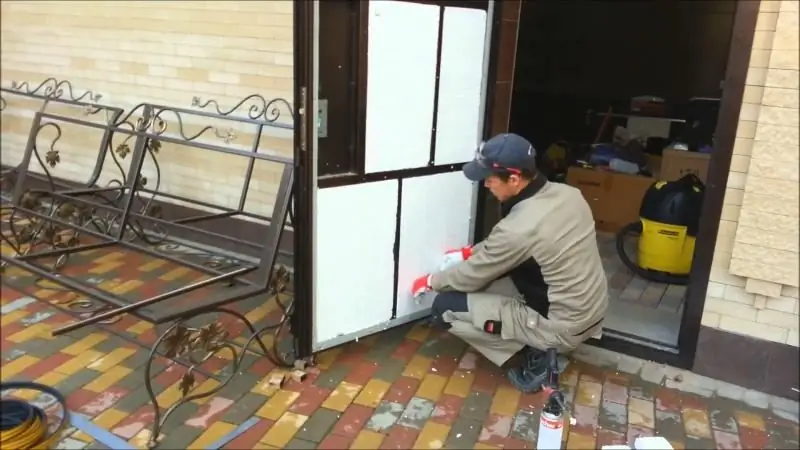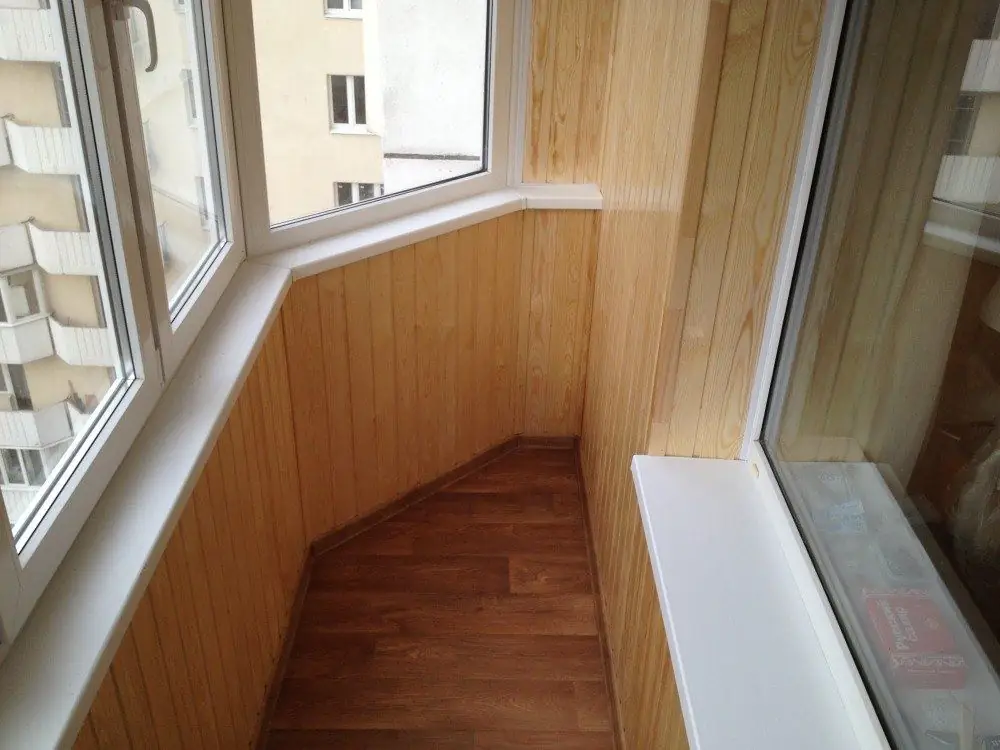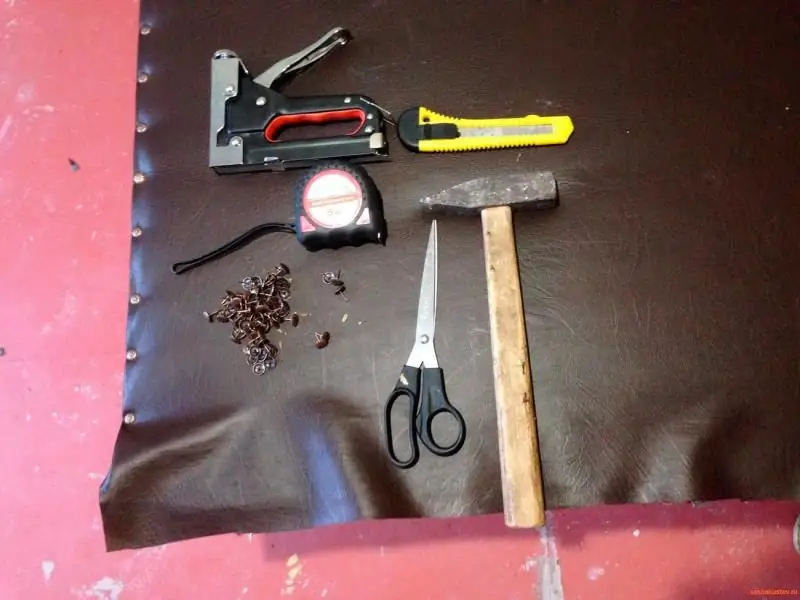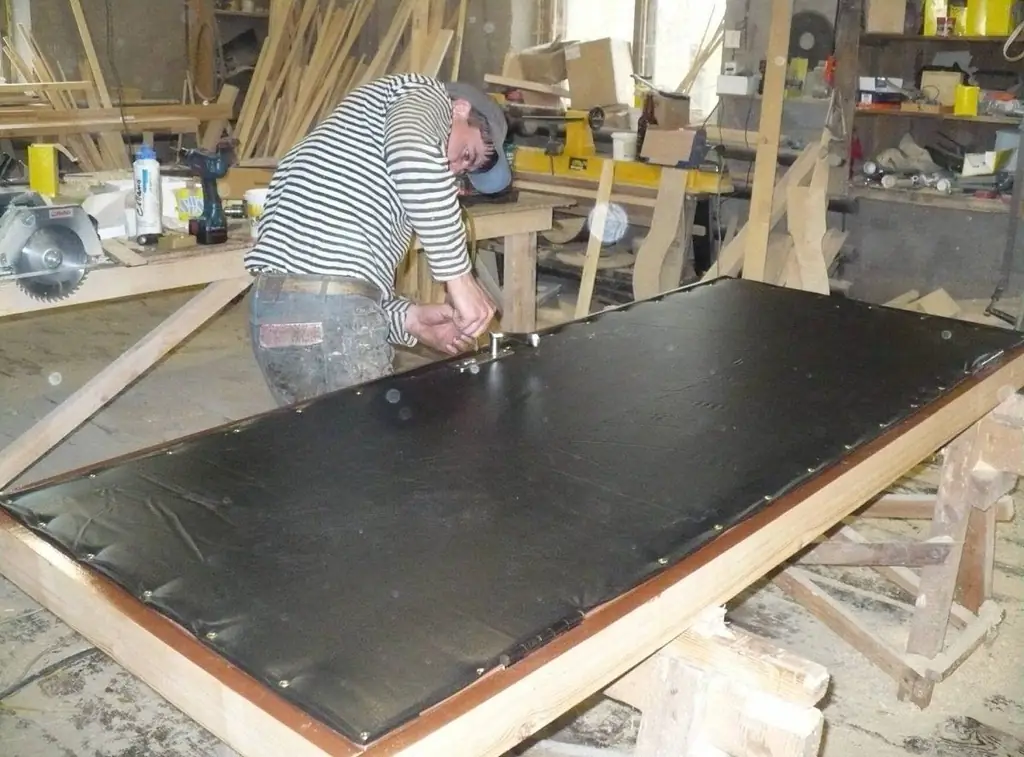
Table of contents:
2025 Author: Bailey Albertson | [email protected]. Last modified: 2025-01-23 12:41
Insulation of entrance doors

To ensure comfort and coziness in the house, it must be well insulated. One of the main measures to reduce heat loss is the thermal insulation of the entrance doors. A properly and properly insulated door helps to save significant money on energy costs during the heating season. In addition, it does not let in sounds from the street or from the entrance.
Content
- 1 Kinds of insulation for doors
-
2 Installation of insulation on various types of doors
-
2.1 Installation of insulation on metal doors
- 2.1.1 Insulation of a split metal door
- 2.1.2 Filling with liquid polyurethane foam
- 2.1.3 Video: insulating a metal door
- 2.1.4 Insulation of one-piece metal door
-
2.2 Installation of insulation on wooden doors
2.2.1 Video: insulating a wooden door
-
-
3 Replacing the door insulation
- 3.1 Video: replacing the door insulation
-
3.2 Replacing the seals
3.2.1 Video: Installing the seals
Varieties of insulation for doors
Consider the main types of insulation materials that are used to insulate the front door:
-
Corrugated cardboard. This is a honeycomb filler, which is notable for its low cost, but its heat and sound insulation indicators are also low. Although the material is made of cardboard, the large number of cells provides it with sufficient rigidity. Corrugated cardboard tolerates temperature changes well, so manufacturers often use it to insulate budget entrance doors. The main advantage of this insulation is its low weight, so a large load is not created on the canvas and on the hinges. Due to low moisture resistance and a short service life, corrugated cardboard is not suitable for high-quality insulation of entrance doors.

Corrugated board Corrugated board is usually used for insulating budget entrance doors
-
Mineral wool. The material has high heat and sound insulation characteristics, it tolerates temperature changes well. To insulate the front door, it is better to use basalt insulation, as it is less afraid of high humidity. The main disadvantage of mineral wool is that it shrinks over time. This minus is especially relevant in the case of front door insulation, since the material is located vertically. In addition, when opening / closing the canvas, blows occur, as a result of which the cotton wool quickly settles. To minimize this disadvantage, additional stiffening ribs can be installed in the door, which will partially prevent shrinkage. It is also recommended not just to lay, but to glue the mineral wool to the surface of the door leaf.

Insulation of the door with mineral wool The disadvantage of mineral wool is that it shrinks over time.
-
Styrofoam. This is the most popular and affordable material for insulating an entrance door. Its main advantages: long service life, reasonable cost, good moisture resistance, low thermal conductivity. Installation of polystyrene is simple and quick, and due to its low weight, the load on the hinges and the canvas increases slightly. Among the disadvantages of this material, it should be noted that it has low sound insulation characteristics, as well as the fact that when heated it emits harmful substances.

Door insulation with foam Polyfoam has a long service life, affordable cost, good moisture resistance and low thermal conductivity
-
Liquid polyurethane foam. It is rarely used to insulate doors due to the fact that it requires special equipment to apply it. After spraying on the door surface, it hardens quickly. The result is a monolithic coating without gaps and gaps. Polyurethane foam has good adhesion, so you do not need to use a frame and fasteners for its installation. He is not afraid of changes in temperature and humidity. The disadvantages of this method of insulation are the high cost and specificity of the application. Some craftsmen use polyurethane foam to insulate the front door. This is the same polyurethane foam, but already in a can.

Door insulation with liquid polyurethane foam At home, you can fill the cavities in the door with foam.
-
Polypropylene foam. It has quite good heat and sound insulation characteristics, is not afraid of humidity and temperature changes and does not shrink. The disadvantage of polypropylene sheets is that, compared to other heaters, they have a higher thermal conductivity.

Expanded propylene Foam plates have a higher thermal conductivity compared to other materials
-
Felt. This is a natural insulation made from wool. It used to be very popular, but now it has been replaced by more modern materials. Felt has good thermal insulation characteristics. Its main drawback is that it absorbs moisture well.

Felt Felt has good thermal insulation properties, but absorbs moisture
-
Foam rubber. Among the advantages of this insulation, it should be noted the low cost and ease of installation. The main disadvantages: high moisture absorption, with temperature drops, it begins to crumble very quickly, which leads to a decrease in thermal insulation characteristics.

Foam rubber Foam rubber has high moisture absorption, with temperature drops it begins to crumble very quickly
-
Foil foamed polyethylene. Although the thickness of this insulation is small, it has good thermal insulation characteristics. Due to the presence of the foil layer, most of the heat is reflected back into the room. This is one of the best ways to insulate a door, which is suitable for both wood and metal doors. Such material is mounted with glue. On sale there is a polyethylene foam with a self-adhesive base. It is enough to remove the protective film and attach it to the door.

Foil foamed polyethylene Foamed polyethylene foam usually has a self-adhesive base, which greatly facilitates its installation
-
Sealing tapes. In addition to ensuring high thermal insulation characteristics of the door leaf, it is necessary to eliminate the possibility of heat leakage through the gap between the door and the frame. To do this, special sealing elements are glued along the perimeter to the canvas or to the door frame.

Sealing tape The sealing tape is fixed to the self-adhesive base
To obtain the maximum result when insulating the front door, experts recommend using several thermal insulation materials at the same time. The most effective solution is to install the foam inside the sheet, followed by sheathing with leatherette on the lining of foam or felt, but there may be other combinations.
Installation of insulation on various types of doors
Insulation installation technology will differ slightly depending on whether it is installed on a wooden or metal sheet.
To carry out the work, you must have the following tools and materials:
- screwdriver;
- electric drill;
- knife;
- a hammer;
- stapler;
- a hacksaw, it is needed for cutting fiberboard or plywood;
- measuring instruments;
- glue;
- fasteners;
- insulation;
- wooden slats;
- a sheet of fiberboard or plywood;
-
finishing material (leather or leatherette).

Door insulation tools To insulate the front door, you will need simple and affordable tools.
Installation of insulation on metal doors
Most apartments have metal entrance doors, so the question of how to properly insulate them is very relevant. Metal doors can be:
- detachable, that is, from the inside of the canvas, the sheathing is attached to the frame with self-tapping screws. It may be an option when the door has only a lining on the outside and a frame, and there is no interior decoration;
- one-piece. The door paneling with the frame is connected by welding, therefore, the structure is non-separable.
Insulation of a detachable metal door
Installation of insulation on a split metal door is performed as follows:
-
The choice of material. At this stage, the type and dimensions of the insulation are determined. To do this, measure the length, height and thickness of the web. If the door does not have an inner lining, then additionally you need to purchase a sheet of plywood or fiberboard, which will then cover the layer of insulation.

Plywood sheet You can use laminated plywood, then there is no need to finish the insulated door
-
Removing the casing. To simplify the work, it is better to remove the door from its hinges and place it on a horizontal surface. After that, the screws are unscrewed and the skin is removed from the inside. There are stiffening ribs inside the metal door, between which the heat-insulating material will be installed.

Metal door with trim removed The trim is removed from the inside of the front door
-
Installation of insulation. In accordance with the cells available in the frame, heat-insulating material is cut out. Its size should be slightly larger so that the insulation fits with a slight interference. The insulation is fixed to the metal surface with “liquid nails” or other glue.

Installation of insulation Foam or other insulation is fixed to the metal surface with glue
- Plating installation. After filling all the cells inside the door, the removed trim is put back in place. If a fiberboard sheet is installed, then markings are made in it for the handle, eye and lock larvae, and then screwed to the frame. Self-tapping screws must be installed opposite each stiffener and 3-4 pieces between them.
- The final stage. With the help of a file and sandpaper, the edges of the fiberboard sheet are processed so that it exactly matches the dimensions of the door.
Filling with liquid polyurethane foam
The hollow space of a metal door can be filled with liquid insulation. In this case, all seams on the canvas must be tight so that the material does not come out.
It is difficult to use this method at home, since special equipment will be needed to obtain liquid polyurethane foam. You can use polyurethane foam, but there is no guarantee that it will be possible to uniformly fill the interior of the door.
Video: insulating a metal door
Insulation of one-piece metal door
When insulating an integral structure with mineral wool, foam and other similar materials, one must be prepared for the fact that the thickness of the canvas will increase and its appearance from the inside will change.
The order of work will be as follows:
-
Dismantling of fittings. All fittings are removed from the door, which will interfere with the work.

Dismantling fittings They remove accessories that will interfere with the work
-
The device of an additional frame. For this, wooden blocks with a section of 25x20 mm are used, which are fastened with self-tapping screws along the perimeter of the door leaf. In order to screw in the self-tapping screw, first, using an electric drill, make a hole, which should be slightly smaller than the diameter of the screw. The bars are installed along the perimeter of the canvas, as well as parallel to the short side of the door to create cells for the size of the insulation.

Insulation frame Frame bars are stuffed along the entire perimeter of the door and horizontally to create cells for insulation
- Insulation laying. Insulation is installed between the slats of the created frame and fixed with glue.
- Cladding installation. A sheet of fiberboard prepared in size is attached to the frame using self-tapping screws.
-
Finishing finish. If laminated fiberboard is used, then you can leave it that way. Otherwise, a layer of foam rubber is fixed on the fiberboard, after which it is covered with leather or leatherette.

Finishing Usually, after insulation, the doors are upholstered with leatherette or leather
- Installation of fittings. It is necessary to reinstall the removed accessories. Please note that after such insulation, the thickness of the door leaf will increase, so the handle, peephole and larva must be of the appropriate size.
Non-detachable metal doors can be insulated with foamed polyethylene foam. It is fixed on a self-adhesive base, has a small thickness and high thermal insulation characteristics, so there is no need to mount an additional frame. After laying the insulation, the canvas is sheathed with leatherette. The use of foil-clad material can significantly increase the thermal insulation characteristics of the door, while its thickness increases slightly.
If you plan to install a new entrance door, if possible, you should leave the old one, since the presence of an air space between the leaves allows you to improve the heat and sound insulation of the room. This is possible when the thickness of the doorway is large and it is possible to install tambour doors.
Installation of insulation on wooden doors
In about 90% of all cases, wooden entrance doors are insulated from the outside.
The order of work will be as follows:
-
Removing the door leaf. To simplify the process of insulating a wooden door, it is better to remove it from its hinges and lay it on supports, for example, on 2 or 4 stools.

Removed door leaf It is much easier to carry out all the work on the door removed from the hinges.
- Dismantling of fittings. Fittings are removed from the canvas, which will interfere with the work.
-
Installation of foam rubber, isolon or felt. In this case, the thermal insulation material is glued to the door surface. After that, it is recommended to additionally secure it with small nails or staples.

Installation of foam rubber Foam rubber is glued to the door leaf
-
Insulation laying. If the insulation is carried out with plate materials (foam, mineral wool), a frame of wooden slats is created around the perimeter of the door, and several transverse stiffeners are also made. After that, the insulation is fixed. The disadvantage of this method is that the thickness of the door increases. You can insulate wooden doors with roll materials, for example, foam rubber or foamed polyethylene. They are glued directly to the surface of the door leaf.

Installation of thermal insulation material Installation of slab insulation in a lathing of slats leads to an increase in the thickness of the door leaf
- Installation of finishing material. After laying the insulation, the doors are sheathed with leatherette or leather.
If mineral wool is used to insulate the door, then it must be closed with a hydro-barrier, since it is afraid of high humidity
To obtain the maximum effect, in addition to warming the door leaf, the following activities are also carried out:
- door frame insulation. First you need to understand what state it is in. To do this, dismantle the slope and inspect the gap between the box and the wall. If necessary, cut off damaged polyurethane foam and fill this space with new. After that, they put the slope back and insulate it;
- insulation of the door contour. On the perimeter of the door, sealing elements are glued to the canvas or to the box. They can be both foam rubber and polymer.
If you carry out the insulation of the front door in the described sequence, then you can be sure that there will definitely not be heat loss in this place in winter.

To obtain the maximum effect, you must simultaneously use several heaters
Video: insulating a wooden door
Replacing the door insulation
Sometimes situations arise when it is necessary to replace the insulation on the front door. Most often this happens in the case of using mineral wool, since during operation it settles and the thermal insulation characteristics of the door deteriorate. To perform these works, in addition to the already mentioned tool, you will need a spatula, which is used to completely remove the glued insulation from the door surface. You can cope with a knife, but with a spatula it will be much faster to complete the job.
Insulation replacement procedure:
- Removing the door from the hinges. If this does not work, the work can be done on the installed canvas, but it will be longer and more difficult.
-
Removing the topcoat. If it is genuine leather and it is planned to use it again, then remove the material carefully. Leatherette upholstery is usually changed along with insulation.

Removing the topcoat Usually, along with the insulation, the upholstery is also changed.
-
Dismantling of insulation. The existing insulation is completely removed.

Dismantling of insulation Completely remove the settled mineral wool
- Installation of a new insulation. This process is carried out as described above.
- Installing a new skin.
Video: replacing the door insulation
Replacing the seals
If you notice that foreign smells and sounds from the entrance began to penetrate into the apartment and a draft appeared near the door, then you need to replace the seal:
- Determined with the installation method. Depending on the door design, the seal can be installed in a groove or on a self-adhesive base.
- Remove the old seal. To do this, use a spatula, after which the surface is degreased.
- The thickness of the seal is selected. To do this correctly, you need to roll out a piece of plasticine in the form of a sausage and wrap it in cling film. After that, it is inserted between the canvas and the box and the doors are closed. The template is removed and its thickness measured.
-
A new seal is fixed. Do this around the perimeter of the door. First, you need to remove the protective film from it, and then fix it on a self-adhesive base.

Installation of the seal Remove the protective film from the seal and fix it on a self-adhesive base
Replacing the insulation and sealing elements on the front door is not difficult on your own, so any home craftsman can do this work.
Video: installing seals
A wide variety of thermal insulation materials can be used to insulate the front door, each of which has its own advantages and disadvantages. To obtain the maximum effect, several insulation materials must be used simultaneously. One of the best options would be to insulate the canvas with foam, install reflective insulation and upholstery with leather or leatherette, as well as install a sealing tape around the perimeter.
Recommended:
Balcony Insulation: Tips And Tricks, Wall And Floor Insulation, The Possibility Of Heating The Balcony + Video

Practical advice and recommendations for the insulation of the balcony. Selection of materials for insulation of walls, floor and ceiling of the balcony, heating
Door Upholstery With Dermantine: Choice Of Material, Tools And Stages Of Work

What is leatherette, its features, advantages and disadvantages. How to choose a material. Different methods of upholstering the door with leatherette and the order of work
Sheathing (upholstery) Of Doors: The Choice Of Material For Finishing, Tools And Stages Of Work

In what cases is door trim necessary. Materials used to cover doors. A necessary tool. The procedure for self-upholstery doors
Insulation Of The Roof From The Inside With Foam: Description And Characteristics Of The Material, Installation Stages + Video And Reviews

How to choose foam for roof insulation. How to properly form a roofing cake. Styrofoam stacking and cutting methods
Insulation Of The Roof From The Inside With Mineral Wool: Description And Characteristics Of The Material, The Main Stages Of Installation

Features and characteristics of types of mineral wool. How to choose a roof insulation. How to properly equip a roof with mineral wool
